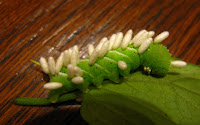 |
| Lichens on rock By Jesse Noar CC BY 4.0 |
Download Episode (6.4 MB, 9.3 minutes)
Show notes:
Microbe of the episode: Cherry chlorotic rusty spot associated partitivirus
Takeaways:
Global climate change is affecting almost every natural system on the planet, in predictable and also sometimes unexpected, complex ways. Microbes perform key roles in many different ecosystems, providing and recycling important nutrients and even macroscopic structure. One example of this is biocrusts in dryland environments, such as areas in the western US with low annual rainfall. Microbes other organisms form a stable surface binding soil and sand particles together, helping to retain moisture and prevent erosion and transformation of land into desert.
In this study of a Colorado park over more than 20 years, important species of symbiotic fungi and photosynthetic microbes in the form of lichens have declined significantly. The land is mostly untroubled by grazing or human activity, but changes in climate and moisture and the presence of invasive plants could affect lichens. However, the temperature increase over the decades showed the best correlation with the lichen decline. The loss of these species could lead to nutrient shortages in the long term for these communities.
In this study of a Colorado park over more than 20 years, important species of symbiotic fungi and photosynthetic microbes in the form of lichens have declined significantly. The land is mostly untroubled by grazing or human activity, but changes in climate and moisture and the presence of invasive plants could affect lichens. However, the temperature increase over the decades showed the best correlation with the lichen decline. The loss of these species could lead to nutrient shortages in the long term for these communities.
Journal Paper:
Finger-Higgens R, Duniway MC, Fick S, Geiger EL, Hoover DL, Pfennigwerth AA, Van Scoyoc MW, Belnap J. 2022. Decline in biological soil crust N-fixing lichens linked to increasing summertime temperatures. Proc Natl Acad Sci USA 119:e2120975119.
Post questions or comments here or email to bacteriofiles@gmail.com. Thanks for listening!
Subscribe: Apple Podcasts, Google Podcasts, Android, or RSS. Support the show at Patreon, or check out the show at Twitter or Facebook.






